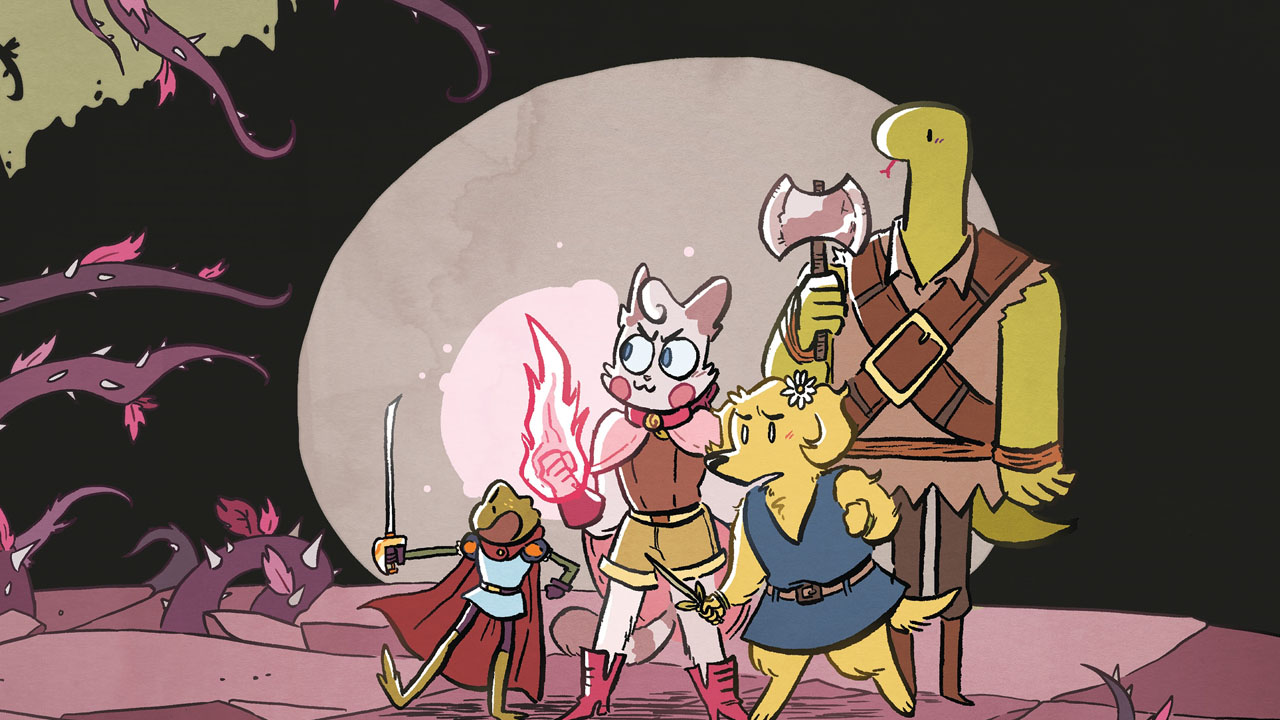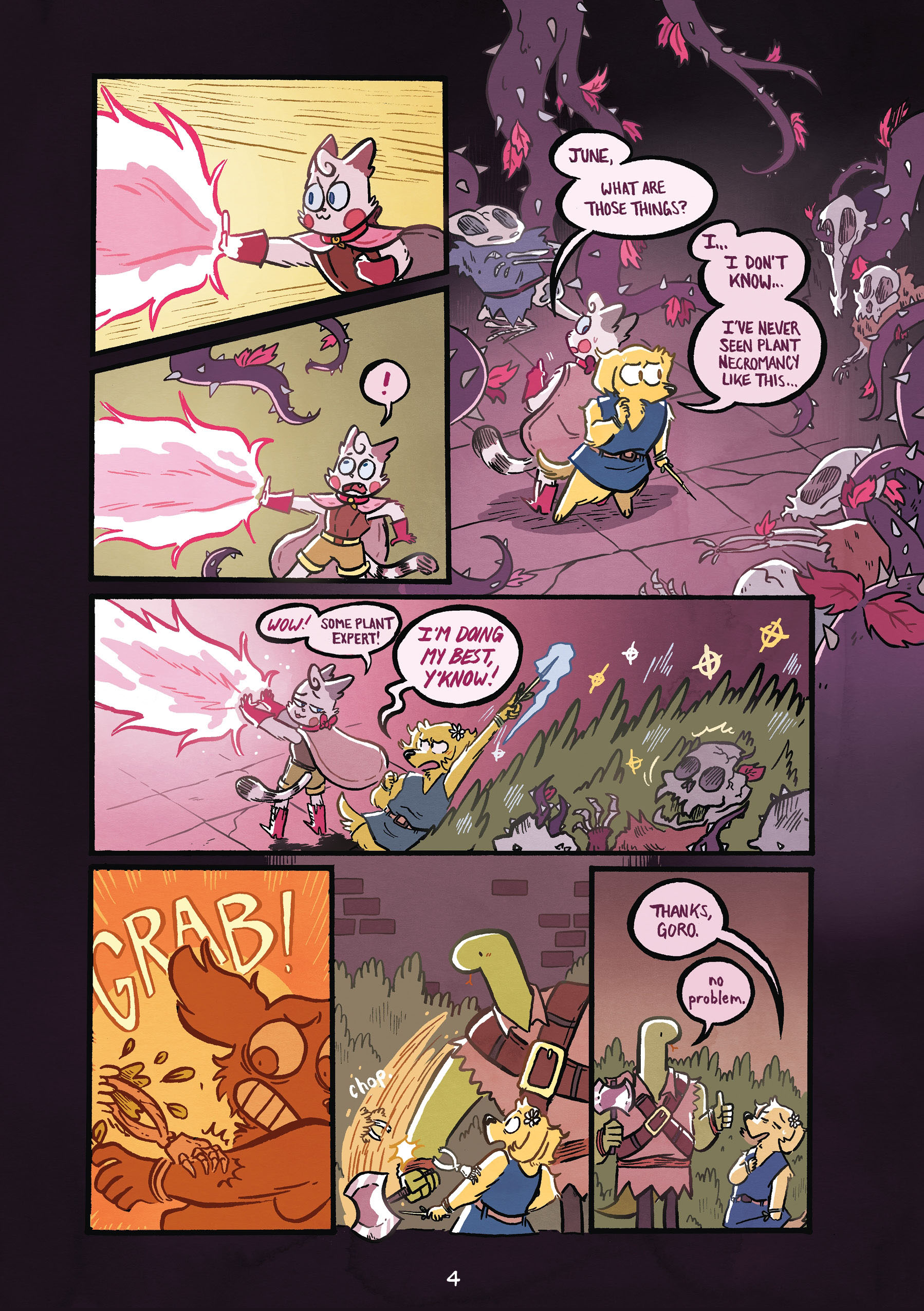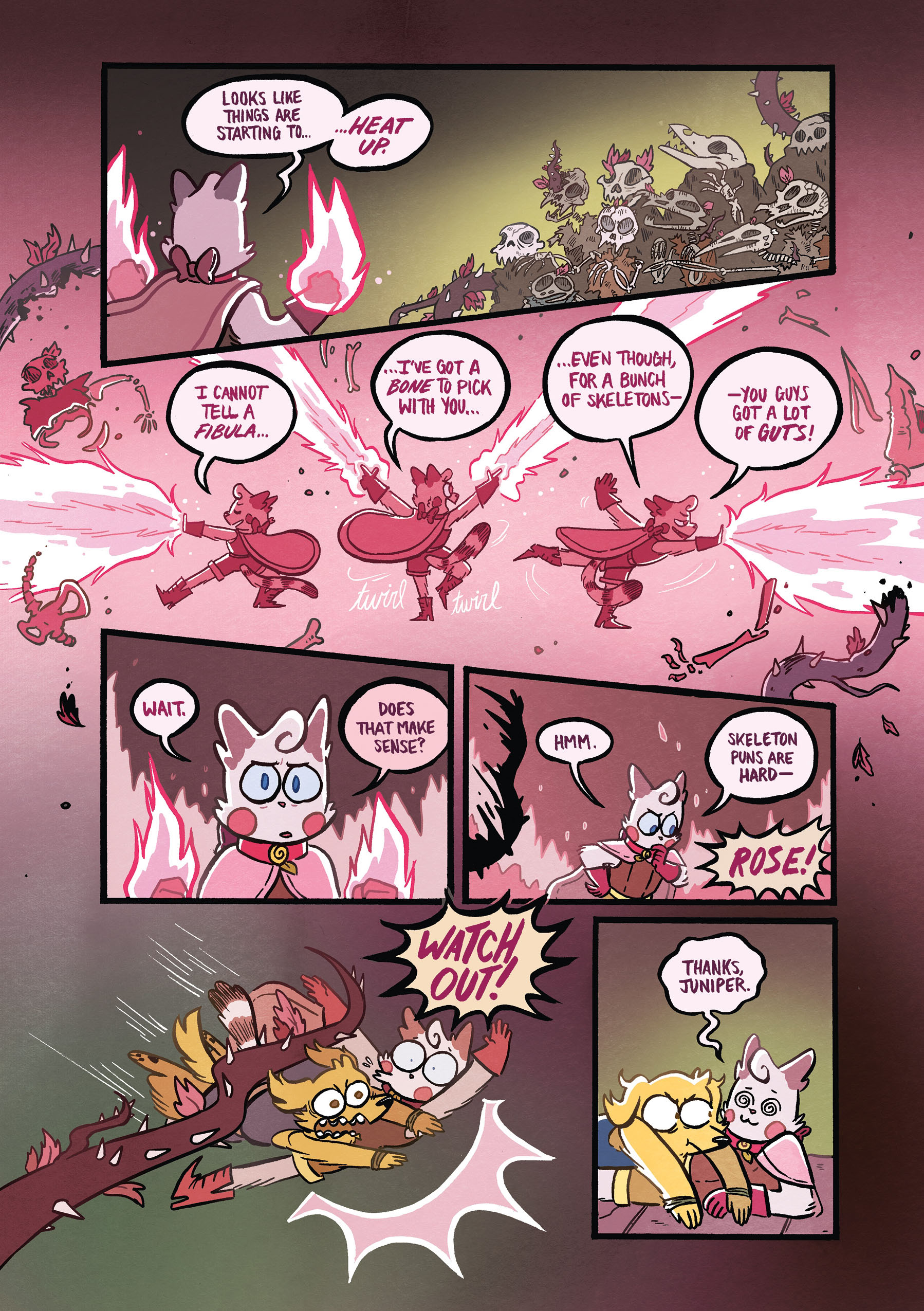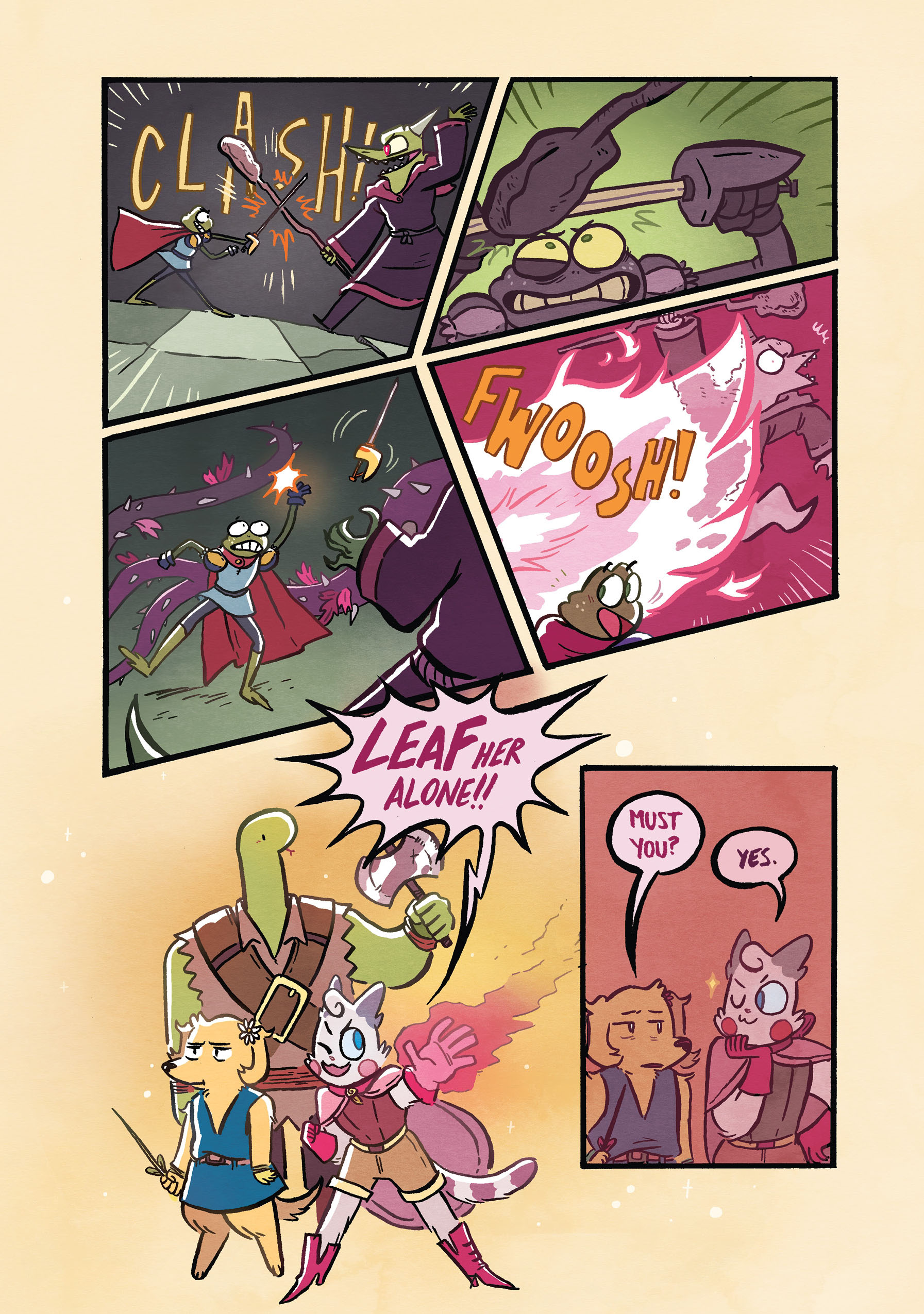Dungeon Critters forges a path from Pathfinder campaign origins to mirthful, charming OGN
Sara Goetter and Natalie Riess talk about their First Second OGN Dungeon Critters

Intrigue, romance, arson -- Dungeon Critters has a little bit of everything. Cartoonists Natalie Riess and Sara Goetter turn their original zine into a full-length graphic novel following four dungeon-crawling pals who navigate not just the rough and tumble adventuring lifestyle but high court intrigue and the looming threat of cataclysmic evils. You know, just little adventuring things.
Inspired by tabletop games, Dungeon Critters captures the off-the-cuff fun of roleplaying with your friends and the emotional turmoil of the moment your GM introduces you to the consequences of your own actions. Riess and Goetter's collaborative work on both the writing and illustration results in a gorgeous graphic novel with a charming cast you'll be itching to adventure with long after you finish reading.
With the OGN debuting this week from First Second, Newsarama spoke with Sara Goetter and Natalie Riess about the campaign that inspired the original zine, Ace Attorney, and the process that brought the full Dungeon Critters graphic novel to life.
Newsarama: Sara, Natalie, what inspired Dungeon Critters originally? And did you know from the start that - did it start as a zine and then you realized in the course of that, you know, 'I think we want to flesh this out a bit more?' - did you kind of know from the start that you had this full graphic novel world in mind for them?

Natalie Riess: Honestly, I think it was a situation where we just really loved working with each other. We had so much fun making the zine that we thought, 'Oh, what about a bigger one?'
Sara Goetter: Yeah.
Riess: What about an OG...what's the anime thing? OVA.
Get the best comic news, insights, opinions, analysis and more!
Goetter: OVA.
Riess: Yeah.
Goetter: So Dungeon Critters started out originally as a Pathfinder game that we played together online with a couple of other people, and we ended up really liking our characters more so than playing the game, a little bit.
Riess: Yeah, I think writing and role-playing are fundamentally very different and maybe we liked the one a little more than the other.
Goetter: Yeah, we ended up just wanting to write just... so we ended up taking our characters and making a story out of that, and that was the zine. And then from there, just kind of coming up with more and more zine ideas and then we had the idea of pitching it as a graphic novel, which at first ended up just being a collection of the zines, plus more zines? But we were told it should have more of a cohesive plot, which turned into the version that it is now.
Nrama: Which characters in Dungeon Critters are based on your characters from the game?
Goetter: I played as Chirp, who back then was a rogue.
Riess: Oh, and I played Rose, who's the cat girl. I think it's funny, because like I feel like it's not quite a one to one mapping though, because when you write a book, essentially every character is you? That seems like a weird way to put it, but yeah, that's the one that I played. I feel like when I was playing the game, I was different from how the character is in the book.

Goetter: Yeah, same with Chirp. Chirp became a completely different character once I had to write her as a character in the story rather than a character in a tabletop game.
Riess: Yeah. Again, because battle tactic games are different from fun comic stories.
Goetter: Yeah, turns out.
Nrama: I think in reading the book, Chirp was the character whose journey sort of hit me hardest personally. It's that pendulum swing from that really classic like tabletop style of, 'I'm being super destructive, but I'm cute and I make really good jokes about it,' and so it's fun. And then having to stop and look back and say, 'Oh, this was fun for me and I recognize now that maybe it had consequences for people who aren't me.'
Can you talk a little about how you found that path for Chirp in the course of the graphic novel?
Goetter: [Laughs] Yeah, I feel like that's how character arcs work? Yeah, I don't know, I feel like Chirp's arc has been kind of haphazard a little, like I didn't even intend for this book to be kind of about Chirp. Not that it's about Chirp, it's about all the characters, but there is an obvious focus on Chirp, because of how it got set up.
I don't know, I just, I guess it just came from like looking at - the way that we wrote this book, is also maybe unusual for a graphic novel. Because we wrote the entire first half in one go. We wrote it, we inked it, and colored it and had it completely finished, and then we moved on to like, there was a second part, and like the third trial part, we wrote completely separately.
Riess: Everything was outlined.
Goetter: Yeah, it was all outlined.
Riess: So we knew where we were going, we had a map. But we changed the road stops along the way, so to speak.
Goetter: It was also very vague, I feel like our outlining.
Reiss: We made sure it was okay.
Goetter: Oh yeah, oh yeah, we had our whole process.
Reiss: I would not start a comic going, 'I don't know.'

Goetter: I still feel like there were a lot of things to figure out with the court case. And also just like character stuff, like character details. I feel like I kind of ended up coming up with, not coming up with on the fly, but, 'Okay, boop.'
I just feel like when you're writing a character, the more you can get a sense of the character, that's easiest, and sort of things fall into place. If that makes sense.
Reiss: Essentially following what's most interesting about the character.
Goetter: Yeah. So the theme of, 'You should take things seriously and like, consider your actions as someone who has power over people,' ends up being a central thing in the last half of the book.
Nrama: You mentioned the way that you sort of outlined the book, towards the end in the back matter, you discuss a lot of your collaborative process, which I really enjoyed reading about. Can you talk a little bit about what it was like working in that particular collaborative style?
Riess: Well, there are more passes of thumbnails, so there's that.
Goetter: Yeah, so many thumbnails. The way that we do writing is we both have a general outline, so we type up on a Google doc that we pass back and forth.
Riess: I tend to handle more of the bones stuff, getting characters from point A to point B, and then Sara writes the banter to make that work better.
Goetter: Yeah, so it's a lot of, we'll write an outline, and Natalie will do the first pass, and I'll do the second pass, and then I'll pass it back to Natalie who will do her final pass, and then I'll actually like, draw the book.
I feel like it works really well, the way that we collaborate because it feels like, it's not like one of us is the writer and one of us is the artist, and if I didn't like a decision and didn't have any say over it. There are jokes that she wrote and are very proud of and we incorporate, or that we collaborated on and expand on into new ideas and stuff like that.
Riess: Yeah I think since we're both cartoonists, we write and draw our own material outside of this, I think the way we think is very comic-focused so there are some writing beats that don't work if you're not spelling them out with the panels and stuff. Does that make sense?
Nrama: Yeah.
Goetter: Yeah, we don't use a script in a traditional sense, also. We go straight from a general outline straight to thumbnails. I think both of us are very paneling-focused because I think the way that you set up and write out a page is way more important than even what the dialogue says exactly. Because I definitely had plenty of pages where I had the layout, but then I'll rewrite the dialogue sixteen times in the course of drawing.
Dialogue is important, but the flow of the page and stuff is very important. I feel like it's a lot different from how I work with my solo work because I feel like when I do solo stuff, I'll just - I can be as vague as I want? And I'll be like, 'I don't know, something happens here, probably.'
But when working with another person I have to be way more specific, in a way that's good. I feel like we also both bring out each other's strengths. Like, Natalie definitely has a really good handle on both structure and action scenes.
Riess: I like to draw action scenes.

Goetter: And I like to draw funny jokes!
Riess: You're good at it though. I think you also get really good emotional turns.
Goetter: Hm. Yeah, I really like drawing characters making dumb faces, or crying.
Nrama: Sara, I wanted to ask you specifically about your lettering. Your lettering is so expressive in a way that is just really amazing to read, could you talk a little about your lettering process? Your lettering is its own character, it's so emotive. It was really wonderful, especially with Goro, which I loved.
Goetter: Oh, thank you. That's very heartening to hear because I worked really hard on lettering and it feels like - so, I have a lot of thoughts about lettering because I always try not to spend three hours just talking about lettering.
Comics is a silent medium, and comics is also such a unique blend of both art and writing, and I feel so many people will just kind of slap the text on top. But I feel like word balloons and lettering and what you can get out of it is pretty integral to comics. I try to incorporate stuff like that whenever I can.
I do believe very strongly that lettering is drawing also. I run into like other people that tell me, 'Wow, that looks really cool, my handwriting looks like crap though.' My handwriting? My regular handwriting, if I'm writing in my journal or whatever, it also looks really bad. It is not readable at all.
But I think treating letters like art, as their own characters, really helps bring it out, and then there's so much you can do with it.
Like with Goro, you can hear what his character might sound like through his lettering. Stuff like the Elder's text. I had a lot of fun playing around with stuff like that, with different kinds of fonts. I am doing this by hand, also, which is maybe annoying for editors. But -
Nrama: But it looks amazing!
Goetter: [Laughs] I do everything traditionally with pen and paper, with my lettering guide and a ruler. And then I just painstakingly kern it in Photoshop letter by letter. So it is definitely a labor of love that would probably be solved if I just made a font of my handwriting, but I feel like that would take away from ... I think the personal touch of doing it by hand is very important to me. The mechanics of lettering is like, ah man. Yeah, that's the good stuff.
Nrama: And Natalie, in terms of color, I've also been a really big fan of your work since Space Battle Lunchtime. And one of my favorite things about Space Battle Lunchtime and also Dungeon Critters is your colorwork. It's a lot like Sara's lettering in that it's so vibrant and it adds so much to the character of the book. Could you talk a little bit about your process there?
Riess: I don't know if this is unique to me, but whenever I remember being in a space, like, anywhere, the thing that really sells that memory for me is the colors and how things looked. So I think when I'm trying to sell a space in a comic, I try to access that memory and think of how that felt, and then translate that onto the page.
But that being said, I think that comics are the most powerful medium, you can do so much with them, you don't have to necessarily stick to what the naturalistic color that environment would be.

I think the most important thing about coloring is communicating. So, again you could be communicating what that space feels like, or you could be splashing it on a drawing, to make it funnier or you could be like emphasizing an emotional beat by using pink or gold or something. One kind of abstract cheat I like to use is picking a theme color for certain things, and then you can take that and if you want to remind the readers subconsciously of a thing that happened in a different part of the book, you can bring back that spooky purple or that warm pink.
This is all super abstract, it's all like, trusting your feelings. But also trusting years of color theory training. So it looks good, but it also looks like how you want it to feel. It's a balancing act.
Goetter: Yeah. I don't know colors that well.
Riess: Your colors look good.
Goetter: Your colors are just, I think they really do bring out ... I feel like when you turn a page, it's like, the tone is kind of the color you see first, it's really important.
Riess: Yeah, the first thing you react to.
Goetter: There's a lot of places in the book where you turn the page and it's just like, it's really colorful in a very cool way. I think it adds to the atmosphere of the book.
Riess: Atmosphere! Sorry! I had this weird long abstract thing where I'm like, I'm trying to use this to make a joke. It's atmosphere!
Goetter: Yeah!
Nrama: In terms of designs, I loved all of the character designs, I loved all the different fashions - how did you come up with the designs for the Critters and the rest of the cast, especially the clothes? Were there any particular visual inspirations you were working from there?
Goetter: Yeah, for character designs, the main four we kind of already had going from the tabletop game. Like we kind of drew those characters already, I think we put some of those drawings in the back of the book, of our very, very old, our first drawings of these characters from when it was still a Pathfinder game. And then, as for the other characters, I think you designed the Baroness.
Riess: Yeah, but you polished them.
Goetter: Yes, I mean if there's any fashion that you like in this book, that's all Natalie.
Riess: I think you designed Chirp's outfit right, and Goro's?
Goetter: Yeah their initial outfits, but that's about it.
Riess: I'm very into fashion history, and so I like looking up these cool dresses and being like, 'Well, this kind of fits the mood, don't worry about the time period.' And I was doing some concept art, and Sara would take that and then polish that down into a usable design for the comic. So I would draw maybe a little too much stitching.
Goetter: I think there were a couple of dresses that you drew that looked very cool but I'm like, 'I have to draw this in a comic, though.' It's a cool illustration, I can't draw this in a comic.

Riess: It's a matter of, I think, again this is super abstract, thinking about what shapes remind you of that character, and also the basics of that character's fashion sense. So Rose, for example, I feel like I want her to look very fancy, but she's not really a dress-type character. So I go for all these, her formal stuff is a cool frock coat, or her puffy sleeves outfit. And shorts, because I feel shorts make her look very action-y.
Goetter: Yeah, while June gets to wear all the nice dresses.
Riess: Even though she's more practical in her normal everyday wear, she does have more dress potential, I feel like. So for her fancy sequences, I get to do, I mean in the first one I draw her, she's disguised as somebody else, so it's a more structured gown, as opposed to one she wears when she's more comfortable, which is more flowing, almost art nouveau-looking thing because she loves nature.
Goetter: Yeah. I always really like your character designs, like the fashion designs. Every Baron outfit is really good.
Nrama: Yeah.
Goetter: There's one outfit that she designed for the Baron that only shows up in exactly one scene.
Riess: Is it the one with the red gloves?
Goetter: Yeah, the one with the red gloves.
Riess: It's so good! I love it! He's wearing this melodramatic white outfit because, I don't want to spoil anything, but it has to do with the mood of the scene, but he's wearing these dumb red gloves.
Goetter: Yeah, there was a scene in the beginning of the book where he has this big neck ruff. After we finished that part of the book, we were like, 'Oh no, he should've changed outfits in the middle of the scene!'
Riess: But we didn't want to redraw the scene.
Goetter: We didn't want to redraw it! But please imagine that he is wearing a different, even dumber outfit towards the end of the first part. It's just fun. I feel like whenever I draw a comic, I have, 'This is the character, and this is their costume, and that's what they wear.' It's not that I don't think about their clothing, but I don't tend to do a lot of costume changes in my personal work.
Riess: But I feel like Boozle's shape, that outfit is so integral to making that shape work.
Goetter: Yeah, I'm also just not very fashion-minded, I guess. But if I have to design a character in their outfit, it takes me so long to design a single outfit that I'm like, 'Whoo! One done, I'm good.'
Nrama: You're serializing the first portion of the book online, leading up to the release date. What prompted that decision? I just think it's really cool that you're doing that.
Goetter: I think it's that we've seen other people who are publishing books do that. I know that Nimona, back in the day, released first as a webcomic.
Riess: I think it was a webcomic before it got picked up.
Goetter: Was it?
Riess: I think Tea Dragon Society did that?
Goetter: Yeah, I think Tea Dragon Society also serialized as a webcomic. We both come from webcomics, so I feel like just having a serially updated story that's free and accessible is important.
Riess: I'm not going to lie, I'm just excited for people to read our book. We finished drawing it....
Goetter: Last year.
Riess: Last summer, spring last year?
Goetter: I think we finished in August. We've also just been very excited for people to read this.
Nrama: It's nice to have something to point to and say like, 'You should buy this book and if you don't trust me when I tell you that you should do that, please read some of it first. And then when you're done, just go buy the book.'
Goetter: Yeah!
Nrama: It's nice to be able to point folks to that.
And my last question, what was your favorite scene in Dungeon Critters either just the scene you like the most or the scene that you enjoyed working on the most, and what are you most excited for readers to get to experience when they pick it up?
Riess: We showed our book to one of our friends just after we finished making it, and I don't want to spoil the twist, but there is a scene with a twist in it, and there's a page turn. So she stopped before turning the page and was like, 'Oh, okay. What?' And then she turned the page and she reacted and it was incredibly gratifying.
Goetter: Yeah, that's a really good scene. What's another good one?
Riess: I like all the ones where Rose and Jane are doing dance shenanigans, and I love drawing evil plans.
Goetter: I think my favorite, like this isn't really a scene as much as it's an entire sequence, but I am very proud of there's a court case.
Riess: The court case rules.
Goetter: Yeah the... basically I remember pitching that to Natalie like, 'Natalie, we should do Ace Attorney as a comic.' I feel like the way it's turned out is some of my best paneling work. I really like being able to get that to work in an exciting way.
Riess: It's also an interesting way to pit two characters against each other, or even set characters against each other that isn't necessarily action.
Goetter: Yeah, because the idea is like Chirp versus ... and being able to have a fight with words and dialogue rather than just, "You look ready to fight," kind of thing, I'm really proud of how that whole sequence turned out.
Riess: Yeah, all my favorites are in the second half of the book.
Goetter: Yeah. We got better as we went along. [Laughs]
I'm very proud of the finale.
Riess: Yeah, good dress in that one.


